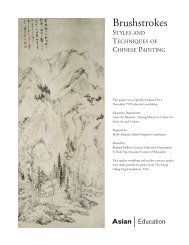Sacred Arts of Tibet (.pdf) - Asian Art Museum | Education
Sacred Arts of Tibet (.pdf) - Asian Art Museum | Education
Sacred Arts of Tibet (.pdf) - Asian Art Museum | Education
You also want an ePaper? Increase the reach of your titles
YUMPU automatically turns print PDFs into web optimized ePapers that Google loves.
The Buddhist stupa/chorten may contain actual physical relics—a fingernail,<br />
bone fragment, or even a hair <strong>of</strong> an enlightened being. It may contain<br />
other ritual objects such as paintings, gilded images <strong>of</strong> Buddhas or deities,<br />
clay votive images, sacred texts, or any consecrated object that is associated<br />
with the Buddha or some other holy person in whose memory the stupa was<br />
erected. Some stupas, such as those built for the Dalai Lamas in the Potala<br />
Palace (see slide 3 and Reading 3) contain the mummified body <strong>of</strong> the<br />
Lama.<br />
Stupas may be several hundred feet high, such as those in Sarnath, India<br />
and Kathmandu, Nepal, or small enough to fit on a family altar such as the<br />
one in the museum’s collection (see the Sri Lankan example below) . Stupas<br />
for the altar can be found alongside a gilded image <strong>of</strong> the Buddha and a<br />
volume <strong>of</strong> sacred text. These represent the Buddha’s three faculties: mind<br />
(stupa), body (image), and speech (text).<br />
<strong>Sacred</strong> <strong><strong>Art</strong>s</strong> <strong>of</strong> <strong>Tibet</strong><br />
Minature Stupa, approx.1800-1900,<br />
Sri Lanka, bronze. Gift <strong>of</strong> Subash<br />
Kapoor, F2000.15.A-.B<br />
How does one worship at a stupa?<br />
Stupas are revered by Buddhists as embodying the mind <strong>of</strong> the Buddha. To<br />
show their respect, pilgrims walk around the structure clockwise, with their<br />
right shoulder closest to the stupa. This act is known as circumambulation.<br />
It brings the worshipper merit, increases faith, and inspires them with the<br />
power to follow the Buddhist path more skillfully and effectively.<br />
What is the symbolism <strong>of</strong> the stupa?<br />
The stupa is a highly symbolic structure with many meanings. They are<br />
built according to strict rules <strong>of</strong> proportion. Most stupas are painted white,<br />
although those used indoors are reliquaries are <strong>of</strong>ten made <strong>of</strong> gold and covered<br />
with gems.<br />
Bodnath Stupa in Kathmandu, the<br />
largest stupa in Nepal.<br />
The three main elements <strong>of</strong> a stupa are the base, dome, and crowning<br />
parts. Taken as a whole the structure evokes the physical presence <strong>of</strong> the<br />
Buddha—the base is his throne, the dome his body, the square on the dome<br />
his face (can you see the eyes painted on Gyanste Kumbum?) the spire his<br />
crown. Its square base represents the earth, and the dome symbolizes water.<br />
The spire represents fire. At the top, joined symbols <strong>of</strong> the moon and sun<br />
represent the union <strong>of</strong> compassion and wisdom, and the upper-most flame<br />
represents highest enlightenment achieved through the perfect union <strong>of</strong><br />
compassion and wisdom.<br />
Inside the Gyantse stupa there are six floors that contain chapels filled with<br />
murals and sacred statues. One does not enter the base <strong>of</strong> the dome where<br />
the ritual <strong>of</strong>ferings are ensconced.<br />
36<br />
Dharmekh Stupa at Sarnath, India.<br />
This is the site where the Buddha<br />
gave his first sermon after attaining<br />
enlightenment.<br />
<strong>Asian</strong> <strong>Art</strong> <strong>Museum</strong>
















